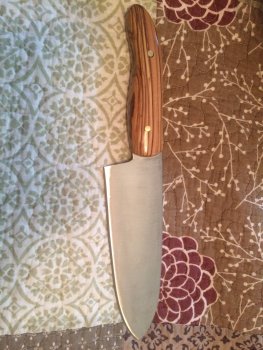Good beginning efforts! Suggestions I would make are.... Attention to detail. This will come with time and repetition, but a few things jumped out at me.
1. On the first image, I noticed that the sharpened edge does not go all the way to the tip of the blade.
2. It appears that these are "machine finishes"? If so, and that's what you desire, that's OK. However, if you take the time and effort in the blade and handle finishes (hand finishing), it will very quickly increase the overall appeal and value of your work.
3. Handle finishes.... it appears that you used some type of "coating" on the handles? Many exotic woods do not require a finish (such as varnish, poly, etc).... hand finishing them down to a fine grit (600-1200) and finishing out with a good quality paste wax give a very good appearance/finish as opposed to coatings such as varnish, poly etc. that can give a "plastic" look.
4. On the second image, the glaring issue that caught my eye is the rear handle pin.....the big glue gap. That's also common when a person gets started, and again, time, and more attention to details will help. There are a lot of little tricks that will help with this, but going slowly and paying close attention to detail is the key.
All of the above is intended to help, not belittle. We all started somewhere, and I did the same things early in my career. Just remember this..... The fastest way to build a knife is SLOWLY.... that way you only have to do it once.

Keep going, and seek improvement with each knife you build. Knifemaking is all about problem solving. Often times in our hast, we create a problem.... the trick is to think things through, go slowly/carefully, and either not create the problem, or more often, learning how to fix the problem we create for ourselves.
I always tell students that the difference between a Good Knifemaker, and any other knifemaker, is that the Good Knifemaker, knows how to minimize, or hide their mistakes!





